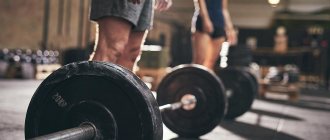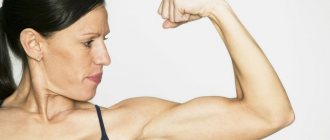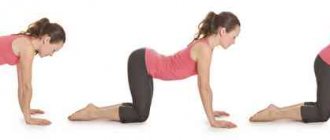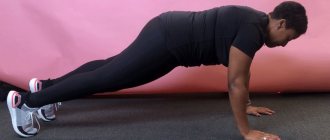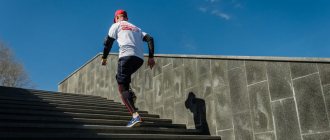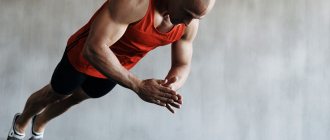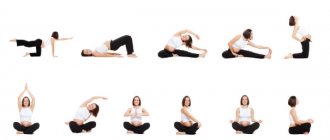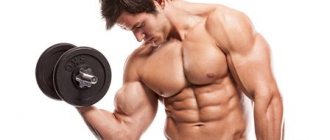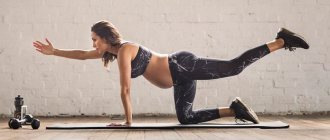Asanas for opening the shoulder girdle. Yoga for the shoulder girdle.
Muscle pain in the shoulders and spasms in the shoulder girdle are familiar to almost all residents of large cities. This set of simple exercises will help you relieve tension from your shoulders.
.
Long hours of work at the computer, endless hours behind the wheel in traffic jams and at home in front of the TV, nervous tension, heavy bags that we carry from the store, hunched over, - all this leads to the fact that our posture is impaired, the mobility of the shoulder joints worsens, and There is tightness, a feeling of heaviness, and pain in the shoulder area.
These negative changes entail a chain of others. In particular, the vital volume of the lungs decreases and, as a result, the flow of oxygen and nutrients to organs and tissues becomes insufficient, and inflammatory diseases occur. To prevent all these troubles, it is necessary to maintain flexibility and mobility of the joints and functional strength of the muscles of the shoulder girdle. How to stretch your shoulders? Mobility of the shoulder joints is also important in yoga practice: without it, it is impossible to master many inverted and semi-inverted asanas, for example, bridges, headstands, forearms and handstands. I suggest you master a simple set of exercises for the shoulder girdle. You can do it in the morning as exercise or in the evening when you return home from work. Do this at least every other day: your shoulders will remain light, your chest proudly unfolded, and your posture royal.
A set of asanas and exercises for the shoulders. Stand straight with your feet hip-width apart and parallel to each other. As you inhale, sharply raise your shoulders to your ears, and as you exhale, lower them as low as possible. Do not bend your elbows. Do 8-10 repetitions.
From the same standing position, make 5-7 circular rotations with your shoulders forward, and then the same amount back.
From the same starting position, spread your arms straight to the sides to shoulder level, palms facing down. Clench your fists and, in a small amplitude, make 8-10 rotations with your shoulders forward, and then the same amount back. Arms should be straight and remain at the level of the shoulder joints.
From the same standing position, feet shoulder-width apart, arms spread to the sides at shoulder level, turn your palms up. Stretch your left hand and body to the left, then your right hand and body to the right. Perform 3-5 repetitions.
Stand straight, arms down, feet hip-width apart. Raise your right arm straight above your head. Stretch it up and the left one down at the same time. Change the position of your hands and stretch again. Perform 3-5 repetitions.
From a standing position, feet shoulder-width apart, right arm extended up, left arm down, bend both arms at the elbows and clasp your palms at the shoulder blades. Only if you can’t clasp your fingers together, use a yoga strap. Stay in this position for 10-20 seconds. Release the grip, raise your left hand, lower your right and repeat the exercise on the other side.
Maintaining the grip as in the previous exercise, as you exhale, bend forward until your body is parallel to the floor. Pull your left elbow forward and up and your shoulders back. Stay in this position for 10-20 seconds. Then turn your pelvis up and, without releasing your arms, bend down as low as possible. Pull your left elbow down and your shoulders up. Hold this position for 10-20 seconds, then carefully rise up, release the grip and perform the exercise in the other direction.
From a standing position, with your feet shoulder-width apart, place your hands behind your back and clasp your palms at the level of your sacrum. As you exhale, bend forward and down, pull your palms, shoulders and shoulder blades as high as possible. Then try to roll your shoulders forward and down and pull your palms towards the floor. Thus, if you cannot rotate your shoulders, continue to pull your arms and shoulders up. Stay in this position for 10-20 seconds.
Get on all fours, place your right palm along the midline of your body under your chest. As you inhale, raise your left arm to the side, then stretch it upward. As you exhale, lower it down, pass it under your right, reach behind it, bringing your shoulder down, and lower it to the floor. Do 8-10 repetitions. Then do the exercise in the other direction.
From a position on all fours, move your pelvis back and lower it onto your heels, arms extended forward. Reach your right arm under your left, palm facing up, right shoulder toward the floor. Place your left palm on your right and, as you exhale, lower yourself into a twist. Pull both arms to the left, pull your right shoulder toward the floor, keeping your pelvis on your heels. Stay in this position for 20-30 seconds, then twist in the other direction.
Stand a small step away from the wall, place your feet hip-width apart. As you inhale, place your palms on the wall above your head, bend your back and try to press your chest completely against the wall. Move your pelvis back and pull your shoulders down. Only if your chest does not touch the wall or you feel pain in your lower back, move a little closer to the wall. Stay in this position for 20-30 seconds.
Place your palms on the wall just above shoulder level. Exhale, step away from the wall and slide your palms down along it until your body is approximately parallel to the floor. Your palms should rest on the wall slightly above your shoulders. Pull your shoulders and shoulder blades back, stretch your neck and look down. Stay in this position for 20-30 seconds. Come out of it, lower yourself to the floor and rest in child's pose.
Symptoms of varicocele
https://youtu.be/EVEZJlLdI74
It is known from practice that pronounced symptoms of varicocele are observed in young men of military age and in sexually mature men.
If the disease is asymptomatic, its diagnosis is possible only at the time of medical examination, since there is no pain or general discomfort. This process is far from safe, as it can lead to a diagnosis of infertility.
The operation is preceded by the following changes in health status:
- during physical activity, sports activities, during sexual intercourse, or fast walking, the pain increases sharply;
- one of the testicles has dropped below the average acceptable level;
- the testicle has noticeably decreased in size (by at least 20%), with pain in the scrotum and lumbar region;
- deformation of blood vessels becomes noticeable, the consistency of the testicle changes;
- the condition of the sperm deteriorates, as can be seen from the spermogram.
An enlarged scrotum is usually noticeable in an upright position. But with an advanced stage of varicocele, it is obvious in any condition.
It is important to seek qualified help in a timely manner, otherwise the consequences of the pathology may be irreversible (infertility).
Varicocele, citing medical statistics, affects 15% of men of all ages. It can be diagnosed in both 10-year-old boys and older men, usually on the left testicle. Right-sided and bilateral vein involvement is extremely rare. Varicocele itself does not pose a threat to a man’s health, but the consequences can trigger irreversible processes.
Varicocele, if left without proper attention, entails problems with the reproductive ability of a man. This is explained by the fact that the outflow of blood in the dilated veins is disrupted, causing stagnation. With varicocele, the temperature in the testicle increases, slowing down spermatogenesis. Insufficient sperm count and immobility make conception difficult or impossible.
The presence of varicocele is detected, in frequent cases, completely by accident, for example, during routine medical examinations. Due to mild symptoms, patients with this diagnosis rarely consult a urologist. The presence of varicocele does not affect sexual life, a man lives in his usual rhythm.
Only after significant physical exertion or sexual arousal can pathology manifest itself with unpleasant pain in the groin area. Upon visual examination in men, sagging of the scrotum and changes in the testicle (decreased) are noticeable. Swelling of the veins is observed on the affected organ.
Yoga for the neck and shoulder girdle. 8 Yoga Poses for the Neck and Shoulders
Here are relatively easy yoga exercises for the neck and shoulders that will help relieve pain and tone and stretch the areas in question.
In general, without unnecessary preludes, let's go! However, it should be noted that you will need yoga bricks or something similar that can serve as a support.
Therapeutic yoga for neck and shoulders
Pose 1.
Grab a couple of yoga bricks. You will need to place them in such a way that one supports the head (it will stand slightly lower), and the other supports the upper spine (as in the photo). Make yourself comfortable, bend your legs at the knees and bring them halfway towards your pelvis. Place your arms out to the sides and flat on the floor. Relax completely and lie there for a few minutes.
Pose 2.
Here we will need bricks again. Place them on edge, at a distance of approximately shoulder width. Now place your elbows on the bricks, keeping them parallel to each other, then exhale and slowly lower yourself between them. You should feel a stretch in the armpits and shoulders themselves.
Pose 3.
Here we will have a gentle twist, which is just appropriate if you have pain in your neck and shoulders. Place the flat side of the yoga brick on the mat to rest your head (cheek) on.
The second brick will support the outstretched arm. In general, you can do without bricks, but some may be more comfortable with them, especially at first.
So, sit on your heels, then lean forward and place your right cheek on a flat brick, while extending your right arm to the left (it lies on the floor). We pull our left hand forward, approximately parallel to the floor, and place it on another brick standing on the edge (see photo).
Stay in this position for 5-7 full inhalations and exhalations, then rise and do everything in the other direction, mirroring the position of your arms and head.
Pose 4.
Everything is simple here. Sit in the lotus position, or in Turkish (you can help yourself with bricks). Push your tailbone forward to lengthen your spine and bring your shoulder blades closer together.
Place your right hand on the opposite side of your head and gently pull towards your right shoulder. There shouldn't be any pain! We do everything smoothly and softly. In the final position (i.e., as far as you have reached), hold for 5-7 breaths, then do it in the other direction.
Pose 5.
This pose helps open the shoulders and chest and also stretches the triceps. If your shoulders are tight, the pose may be difficult. In this case, you can use a yoga strap, or any strap at all.
We sit on our heels. As we exhale, we raise our hands above and below, and try to grab each other with our palms. We maintain this position for several breaths, then change the position of the hands to the opposite.
Pose 6.
We sit on our heels. The tailbone should be tucked forward (i.e., do not arch in the lower back) to lengthen the spine. Grab your head with your hands and gently pull your head down towards your chest. Don't round your upper back as you do this. When you reach maximum stretch, hold this position for 5-7 breaths, then slowly raise your head.
Pose 7.
Sit up straight on your heels. Interlace your fingers under your chin. Keep your elbows together, in front of you. As you inhale, raise your elbows as high as possible without lifting your chin. Raise your elbows high enough to feel a stretch in your shoulders and sides of your chest.
As you exhale, lower your elbows. Repeat several times.
Pose 8.
We can say that this is a continuation of pose 7. As you exhale, lower your elbows in front of you, and, as you inhale, bring them together and, with effort, press them together, while gently moving your head back. Then lower your head, lie on your back and relax.
Here is such a simple yoga for the neck and shoulders, which is suitable even for beginners.
Types of Laparoscopies
In modern medicine, it is customary to use several methods to eliminate the described pathology, the characteristics of each of which will directly determine the period and characteristics of recovery after surgery.
Options:
- Open surgery involves ligating the affected testicular vein, which prevents its subsequent increase in size. This stops the movement of blood through deformed channels. It is currently used in practice infrequently, because it can lead to complications in the form of hydrocele, and relapse is possible. Prolonged rehabilitation period.
- A microsurgical operation is performed when the patient’s condition sharply deteriorates, when there are complaints of severe pain in the testicle, groin, or scrotum, and the spermogram shows a poor result.
- Endoscopy is a procedure in which a minimal degree of tissue trauma is observed in the area with pathological changes. This varicocele operation can be performed on 2 testicles simultaneously. The recovery period is short.
- Mini-access surgery is indicated in the absence of a sharp deterioration in health. During this operation, no incision is made into the abdominal wall, and accordingly, recovery takes place in the shortest possible time. As for complications, hydrocele is extremely rare.
https://youtu.be/B2e-EqS33ew
For varicocele, several types of laparoscopy are used, aimed both at carrying out diagnostic measures and at eliminating the disease.
In fact, there are a lot of types of operations, but from them we can highlight the main ones that are most often used.
Ivanissevich method, or direct access. This method is traditional and often used. During the operation, the surgeon makes a 4 cm incision and ligates the testicular vein, as well as all affected veins. It is allowed to be carried out at any stage of the disease.
The veins on the left side are anatomically more vulnerable to varicose veins, so this type accounts for 80% to 90% of cases. The smallest number of diagnoses was registered on the right side, while neoplasms on the right kidney cannot be excluded.
Regarding the level of development, the gradation proposed by the World Health Association is most often used, where there is one preclinical stage, which occurs latently, and three clinical stages, which have a set of distinctive characteristics.
Classification of varicocele proposed by WHO
When making a diagnosis, it is important to undergo an ultrasound and a spermogram, even if there are characteristic external symptoms. The data obtained is extremely important for monitoring the situation and assessing the success of treatment.
Shoulder exercises for women. Exercises for the shoulder girdle
Shoulder press with dumbbells.
Exercises for the shoulder girdle that will be useful for women can be divided into three main categories:
- Raise your arms to the sides.
Each category consists of several variations of a core exercise, allowing you to choose the exercises that best suit your goals and anatomy.
The shoulder press makes up the fourth commonly mentioned category of shoulder exercises. However, it is better for women to refuse to perform it for the following reasons:
- The bench press effectively works the anterior deltoid muscles. If you intensively train your chest muscles, you do not need to separately stimulate the anterior deltoid muscles, since they develop more actively than other muscles of the shoulder girdle.
- Performing bench presses and shoulder presses puts unnecessary stress on your shoulders, elbows, and wrists, which can lead to injury and pain. Eliminating the shoulder press from your training program will save time and reduce stress on your joints.
- Overdeveloped anterior deltoid muscles disrupt posture.
- Typically, the most underdeveloped area of the deltoid muscles is the posterior bundles. You should focus your efforts on their development.
How to relax the muscles of the shoulder girdle. Various ways to relax the muscles of the neck and shoulders
Throughout the day, human muscles experience stress. This happens even among those people who do not engage in physical labor and lead a sedentary lifestyle. After a day spent at a desk or computer, a person often feels tension in the back, neck and shoulders. Regular tension that accumulates in the muscles leads to back pain, headaches, dizziness, malnutrition of the spine, lumbago and spasms in the neck and shoulders, and the development of cervical osteochondrosis.
Causes of muscle tension
The most common cause of muscle strain in the neck and shoulders is improper body position while sitting at a desk or computer desk. If the table does not fit the size of the chair, then the shoulders of the person sitting are raised, and sitting for a long time in this position causes muscle tension. The same thing happens if a person slouches and pushes his shoulders forward. The trapezius muscle gets tired and begins to hurt.
Incorrect position during sleep, sedentary work, excessive physical activity, as well as emotional tension and stress negatively affect the condition of the muscles of the shoulder girdle.
According to Chinese medicine, the cervical-collar area contains the most important energy and reflexogenic point, which is responsible for the motor activity of the hands and brain activity. In the neck area there are 4 large arteries and 8 nerves, as well as the spinal canal. They are responsible for the blood supply to the organs of the head, chest, and arms. 32 neck muscles support the head and help make movements. Therefore, relaxing the shoulders and neck is very important for the harmonious functioning of the whole body.
Tired and overstrained muscles of the neck and shoulder girdle cause poor circulation, which can lead to a decrease in oxygen supply to the brain and a deterioration in metabolism. To prevent this from happening, it is necessary to regularly relieve tension and relax the muscles of the cervical-collar area.
Exercises to relax the muscles of the neck and shoulders
There are special exercises to relax tired muscles. They can be done after work at home or even in the office during a break. You need to do the exercises slowly, without sudden movements, well working on the areas in which the strongest tension is felt.
Exercise 1
Starting position when performing a set of exercises: sit on a chair, back straight, shoulder blades reaching towards each other, legs standing flat on the floor. While in this position, stretch the top of your head up, imagining that someone is pulling it by a thread, and at the same time lowering your shoulders. Stay in this position for a few seconds, then relax. Repeat 3 times.
Exercise 2
Lower your chin down, relaxing your neck. Stay in this position for about 30 seconds, and then begin to slowly turn your head left and right (your head remains lowered). Then throw your head back and also smoothly shake it from side to side.
Exercise 3
Join your hands at the back of your head, lower your elbows. Apply pressure with the back of your head to your palms, slightly lifting your head. Hands resist pressure. Afterwards, you need to relax your neck muscles by lowering your head. Repeat the exercise, alternating tension with relaxation.
Exercise 4
This exercise is similar to the previous one, only now you need to place your hands on your forehead. Press your forehead onto your palms, while simultaneously creating resistance with your hands. It is important that only the muscles above the shoulders are tensed, and that the head and arms do not move.
Exercise 5
Slowly raise and lower your shoulders several times, holding each position for 5 seconds. Repeat several times.
Exercise 6
Rotate your shoulders forward and backward (8 rotations in each direction).
Exercise 7
Place your hands on your belt with your fingers pointing forward. Reach your elbows behind your back towards each other, trying to open your chest as best as possible. Then relax. Repeat several times. You can also practice various modifications of this exercise, such as closing your palms behind your back.
Exercise 8
Stretch your head up, while slowly turning your head left and right. Then tilt your head back slightly and smoothly roll it from one shoulder to the other. Make sure that the exercise does not cause pain.
Exercise 9
Sitting on a chair, slowly lower your torso until your stomach touches your thighs. You need to lower your head first, then your upper back, and then bend at the waist. The arms hang freely. Stay in this position for a while and also slowly straighten up in the reverse order.
Exercise 10
Sit on a chair near the table. The back is straight. Place your elbows on the table and rest your chin on them. Pressing your chin onto your palms, create resistance with your hands. Stay tense for a few seconds and then relax. Repeat several times.
Exercise 11
Place your right palm on your right cheek. Press your cheek onto your hand, creating tension. Hold for a few seconds and then relax. Do the same with the left side.
Exercise 12
To perform this exercise, you will need dumbbells weighing about 2 kg or two plastic bottles of water. Stand straight, holding dumbbells (bottles) in your hands. Hands down, back straight. Slowly raise and lower your shoulders. Repeat several times.
Relaxing massage
Massage is a very effective and pleasant way to relax tired neck and shoulder muscles. It’s good to have someone nearby who can massage your shoulder area after a hard day’s work. But even if you don’t have an assistant, you can do it yourself.
You need to stand up straight and put your hands on the back of your neck. Slowly stroke the neck, do not press too hard. Then start rubbing your neck with your fingers, tapping and pinching it, little by little grabbing the muscles above the shoulders. Movements must be performed from top to bottom. The massage can be performed with the left and right hands alternately or with both hands at the same time. You also need to pay attention to the back of the head and the depression at the base of the head. It is advisable to massage the head itself. This self-massage helps you quickly achieve relaxation.
Prevention of muscle tension and fatigue
To prevent overstrain of the muscles of the cervical-collar area, it is enough to follow some simple recommendations.
- Throughout the day, constantly monitor your posture and do not slouch.
- While working, periodically give your muscles a rest: get up from the table, lean back in your chair, turn your head from side to side, roll your shoulders.
- During telephone conversations, try not to press the receiver to your ear with your shoulder.
- Choose a good mattress for your bed. Don't sleep on a high pillow.
- Choose a comfortable desk and chair so that you don’t have to bend over or slouch while working.
- In the evening after work, it is recommended to take a warm shower and relax physically and emotionally.
Relaxation exercises and massage help relieve accumulated tension and maintain flexibility and mobility of the neck and shoulder muscles at any age.
Treatment
Like any other disease associated with the treatment of varicose veins, varicocele requires surgical intervention.
https://youtu.be/EdGvmQCpSvk
Main indications for surgery:
- Pain in the testicle area.
- The manifestation of male infertility caused by a decrease in sperm motility or quality.
- Severe enlargement of the scrotum.
- Stopping testicular development during puberty.
Some doctors believe that this operation should be performed on all boys to avoid the development of the disease. After surgery for varicocele, all symptoms disappear, and reproductive function improves.
Treatment of varicose veins can only be carried out surgically. Drug therapy is indicated in the preoperative period to stabilize the disease or during surgical treatment. Traditional or other alternative medicine does not have the desired therapeutic effect, and therefore should not be taken seriously.
The operation can be done in more than a hundred ways, but today there are about ten of the most popular techniques. Among them there are classic ones, used for quite a long time (operation according to the Palomo and Ivanissevich method) and modern ones, characterized by low trauma, high efficiency, short rehabilitation time and low incidence of postoperative complications.
These include:
- microsurgical varicocelectomy using the Marmara technique;
- endoscopy or laparoscopy (shown in the photo);
- embolization or sclerotization;
- revascularization of the testicular vein.
An indication for surgery for varicocele may be a poor spermogram or discomfort accompanied by nagging pain during sexual intercourse. The fear that erectile dysfunction may occur after surgery is absolutely unfounded.
Gymnastics for the shoulder girdle. How to do the exercises correctly
When starting to exercise and perform exercises for the muscles of the shoulder girdle, many make a serious mistake that everyone knows about, but almost no one wants to listen to this advice right away. The time spent on the exercise and the number of these exercises per session are of great importance.
If an untrained person begins to perform a complex for developing the muscles of the shoulder girdle, then experts advise first of all to start doing gymnastics for 15–20 minutes a day. Class time can be gradually increased only after a week of classes, and in some cases only after a month.
All movements must be performed with correct posture, especially when performing exercises with weights (dumbbells, kettlebells). Only in this case, the load is evenly distributed on the muscles of the neck and shoulder girdle, and not just on the back and arms. Feet must be placed firmly at shoulder width. Do not lean forward during exercises.
Gymnastics, where the muscles of the shoulder girdle and shoulder are involved, must be performed first at a fairly slow rhythm, then gradually increase the rhythm of movements. In this case, the load on the muscles will be felt more, and the muscles of the upper shoulder girdle will not “ache” and hurt the next day after gymnastics.
Other restrictions for varicocele in men
Service in the Ministry of Internal Affairs is allowed with varicocele, however, when passing the annual medical commission, the employee will definitely receive a referral from the surgeon for treatment (surgical intervention or conservative therapy).
Is it possible to do jelqing? This is a physical enlargement of the penis due to its stretching through special exercises. Again, this is allowed, but in stages 3 and 4 you should abstain.
After the operation, too, until the sutures (including internal ones, if any) heal completely. In the future, it is not prohibited to increase the size of the penis, but it is advisable to periodically consult with a urologist, surgeon, sexologist and, if necessary, an endocrinologist (dealing with hormonal disorders).


